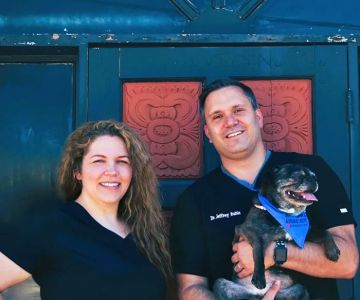Teaching a Dog to Walk Calmly on a Leash: Effective Training Tips
Walking your dog should be an enjoyable activity, but if your dog pulls, tugs, or constantly tugs on the leash, it can turn into a frustrating experience. I remember when I first got my dog, Max. Walking him was like trying to control a freight train on four legs! He was so excited, and every time I put the leash on him, it felt like a race to see who could move faster. After several months of frustration, I realized that teaching him to walk calmly on a leash wasn’t just about controlling his excitement—it was about building a positive, calm relationship around walking. Over time, I learned that with the right training methods, leash walks could become a peaceful and enjoyable experience for both of us.
1. Understanding Why Dogs Pull on Leashes
Before diving into the training process, it’s important to understand why dogs pull on the leash in the first place. In Max’s case, his pulling was a combination of excitement and a natural instinct to explore. Dogs tend to pull when they’re eager to get to a specific destination, whether that’s a new scent or simply moving faster. For some dogs, pulling is a learned behavior because they’ve never been trained to walk calmly on a leash.
Dogs, especially high-energy breeds like Max, tend to act on impulse. In his mind, the faster he pulled, the sooner we would get where he wanted to go. It wasn’t until I realized this that I understood I needed to teach him a new behavior—one that helped him walk at a steady pace without dragging me behind.
2. Choosing the Right Leash and Harness
One of the first things I changed when I started training Max was his leash and harness. At first, I used a regular collar, but I quickly discovered that it wasn’t the most effective tool for preventing pulling. In fact, pulling on a collar can actually harm your dog’s neck and throat, especially if your dog pulls hard. After researching different options, I decided to try a front-clip harness.
A front-clip harness attaches the leash to the front of the chest, which redirects your dog’s movement. When your dog pulls, they’re gently turned toward you, rather than being able to continue pulling forward. This harness makes it harder for a dog to pull and encourages them to walk calmly next to you. I found that this made a huge difference with Max—he wasn’t able to pull as much, and it gave me more control during walks.
3. Start Training Indoors Before Going Outside
When I first started training Max to walk calmly, I didn’t want to deal with too many distractions right away. So, I began practicing indoors before heading outside. Training in a quiet space allows your dog to focus on you without being distracted by cars, other dogs, or people. I began by attaching the leash to Max’s harness and walking around the living room.
Each time Max pulled, I stopped walking and waited for him to return to my side. I made sure to reward him with praise and treats whenever he walked calmly next to me. Over time, he started to learn that walking by my side was more rewarding than pulling.
3.1 Teaching the "Heel" Command
While practicing indoors, I introduced Max to the “heel” command, which is a crucial part of leash training. The idea behind this command is to teach your dog to walk calmly by your side, rather than ahead of you. Here’s how I taught Max:
- Start slow: I would walk a few steps, and every time Max walked beside me without pulling, I’d say “heel” in a calm tone and give him a treat.
- Increase duration: As Max got the hang of walking calmly beside me indoors, I increased the duration of our walks and gradually introduced new distractions, like toys and sounds.
- Consistency is key: Whenever Max started to pull, I stopped moving until he calmed down and returned to my side.
By reinforcing the “heel” command with positive reinforcement, I made sure that Max understood the importance of walking calmly beside me.
4. Practice Outside with Distractions
Once Max was comfortable walking calmly indoors, I moved the training outside. The first few walks were still a challenge because there were more distractions outside—other dogs, people, and new smells. I kept the training sessions short and focused, always rewarding Max when he remained calm. It was crucial to keep the sessions positive so that Max didn’t get frustrated.
4.1 Short Sessions, Frequent Practice
Rather than doing one long walk, I broke our training into shorter sessions throughout the day. This kept Max from becoming too overwhelmed and allowed him to stay focused on learning. We practiced walking for about 10-15 minutes at a time, rewarding calm behavior and taking breaks when necessary.
4.2 Keep the Leash Loose
One of the most important lessons I learned while training Max was to keep the leash loose. Tension in the leash often leads to more pulling, as your dog will feel that they need to pull against the pressure. Whenever I noticed that the leash was tense, I would stop walking and wait for Max to calm down. When he relaxed and the leash became slack, I would resume walking. Over time, Max learned that pulling didn’t get him anywhere, and a loose leash meant we could continue on our walk.
5. Rewarding and Reinforcing Calm Behavior
Max responded best to positive reinforcement, so I made sure to reward him for good behavior. Each time he walked calmly by my side or responded to the “heel” command, I rewarded him with treats and praise. I also made sure that every walk was fun for Max, so he could associate calm walking with positive experiences.
I didn’t expect perfection overnight. There were definitely moments when Max got distracted and tried to pull, but I always remained calm and consistent. Over time, I noticed a significant improvement in his behavior, and walks became much more enjoyable for both of us.
6. Additional Tips for Successful Leash Training
Throughout the process of teaching Max to walk calmly on a leash, I discovered a few additional tips that helped make the training smoother:
- Stay calm and patient: Dogs can pick up on your emotions, so staying calm and patient helps keep the training experience positive.
- Use the right equipment: As mentioned earlier, a front-clip harness or head halter can make a big difference in preventing pulling.
- Vary your route: Changing up your walking route can keep things interesting for your dog and prevent boredom.
- Don’t yank the leash: If your dog pulls, avoid jerking the leash. Instead, stop and wait for them to return to you.
With time and practice, I was able to teach Max how to walk calmly and confidently on a leash. Today, our walks are one of the most enjoyable parts of our day. I hope these tips help you train your dog to walk calmly too!











